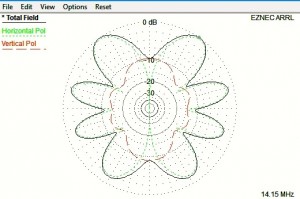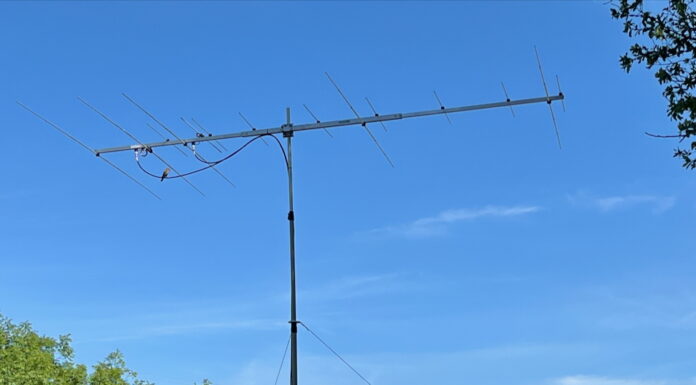I began with the ARRL Antenna Book and the version of EZNEC than comes in the book. That got me thinking that this could actually work. I then purchased ARRL Antenna Modeling for Beginners by Ward Silver, N0AX. Working with the existing models from the ARRL and making the tweaks as to height and angles that would apply to my backyard, I began to gain some insight.
I first looked at a simple 80 meter inverted vee that I’d built to help me generate higher angle radiation for contests, something higher than the Butternut HF2V vertical that I have in place for 80/40/30. However, I had to bend the legs of the inverted vee 90 degrees to fit into my yard. Plus, the push-up mast that I use only goes to 30 feet. So I tweaked the standard dipole model by bending one leg 90 degrees, lowering the center height to 30 feet and the ends of the wires to 6 feet. Examining the plots, I found that it didn’t make much difference how I put up that inverted vee. It was still going to be generally omnidirectional and send a great deal of the signal into the clouds. Still, that might work well to cover some closer stations during the contest evening and morning hours. So the software helped me confirm my suspicions about the antenna’s expected performance.
I had also been considering a Carolina Windom that could be wedged into my yard by running the long end down the side of the house and the short end across the back yard fence. It could only get to 30 feet high, but I had a reasonable chance of getting the ends of the antenna to 30 feet as well. So the real question was, would it make any significant difference over my verticals?
I took the existing ARRL model of a 20 meter Carolina Windom at 50 feet and began the modifications. Note that the Carolina Windom uses a vertical feed line as part of the radiating antenna. It also has an offset feed point, with one short leg and one long leg. As noted above, its dimensions would fit nicely in my yard.
I first captured an azimuth plot of the original model, which you can see in the slide show below. It shows several radiation lobes. I then bent the long leg to a 90 degree angle with the short leg. That azimuth plot is shown next. Basically a bit of a skew in the pattern. That could work nicely toward Europe. All this was done at the model’s original height of 50 feet. Then I lowered the model to 30 feet. You can see that plot next. Ugh, starting to get a bit omnidirectional, with one null point. Then I looked at the elevation plot of the same model and found that it at least gets the radiation going toward the horizon rather than the clouds.




Given all that, it’s given me some food for thought. Would it be worth erecting such an antenna? Not really sure. The wire runs would either interfere with my verticals or I’d have to take them down. Not sure I would really gain very much.
As you can see, however, this additional information has been very helpful in exploring a new antenna thought without the time and expense of building it with wire. Very helpful to wrestle with these concepts on the computer rather than with wire and masts. Antenna modeling, something for you to consider as you’re thinking about what might fit in your space.








